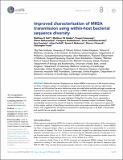Files in this item
Improved characterisation of MRSA transmission using within-host bacterial sequence diversity
Item metadata
| dc.contributor.author | Hall, Matthew D | |
| dc.contributor.author | Holden, Matthew TG | |
| dc.contributor.author | Srisomang, Pramot | |
| dc.contributor.author | Mahavanakul, Weera | |
| dc.contributor.author | Wuthiekanun, Vanaporn | |
| dc.contributor.author | Limmathurotsakul, Direk | |
| dc.contributor.author | Fountain, Kay | |
| dc.contributor.author | Parkhill, Julian | |
| dc.contributor.author | Nickerson, Emma K | |
| dc.contributor.author | Peacock, Sharon J | |
| dc.contributor.author | Fraser, Christophe | |
| dc.date.accessioned | 2020-01-14T10:58:16Z | |
| dc.date.available | 2020-01-14T10:58:16Z | |
| dc.date.issued | 2019-10-08 | |
| dc.identifier | 262880770 | |
| dc.identifier | 9b7ed0d6-5d4e-44ac-a9d1-b119c83837be | |
| dc.identifier | 31591959 | |
| dc.identifier | 85074463963 | |
| dc.identifier | 000506842000001 | |
| dc.identifier.citation | Hall , M D , Holden , M TG , Srisomang , P , Mahavanakul , W , Wuthiekanun , V , Limmathurotsakul , D , Fountain , K , Parkhill , J , Nickerson , E K , Peacock , S J & Fraser , C 2019 , ' Improved characterisation of MRSA transmission using within-host bacterial sequence diversity ' , eLife , vol. 8 , e46402 . https://doi.org/10.7554/eLife.46402 | en |
| dc.identifier.issn | 2050-084X | |
| dc.identifier.other | ORCID: /0000-0002-4958-2166/work/64361293 | |
| dc.identifier.uri | https://hdl.handle.net/10023/19273 | |
| dc.description.abstract | Methicillin-resistant Staphylococcus aureus (MRSA) transmission in the hospital setting has been a frequent subject of investigation using bacterial genomes, but previous approaches have not yet fully utilised the extra deductive power provided when multiple pathogen samples are acquired from each host. Here, we use a large dataset of MRSA sequences from multiply-sampled patients to reconstruct colonisation of individuals in a high-transmission setting in a hospital in Thailand. We reconstructed transmission trees for MRSA. We also investigated transmission between anatomical sites on the same individual, finding that this either occurs repeatedly or involves a wide transmission bottleneck. We examined the between-subject bottleneck, finding a wide range in the amount of diversity transmitted. Finally, we compared our approach to the simpler method of identifying transmission pairs using single nucleotide polymorphism (SNP) counts. This suggested that the optimum threshold for identifying a pair is 39 SNPs, if sensitivities and specificities are equally weighted. | |
| dc.format.extent | 1572305 | |
| dc.language.iso | eng | |
| dc.relation.ispartof | eLife | en |
| dc.subject | QH426 Genetics | en |
| dc.subject | QR Microbiology | en |
| dc.subject | RB Pathology | en |
| dc.subject | DAS | en |
| dc.subject.lcc | QH426 | en |
| dc.subject.lcc | QR | en |
| dc.subject.lcc | RB | en |
| dc.title | Improved characterisation of MRSA transmission using within-host bacterial sequence diversity | en |
| dc.type | Journal article | en |
| dc.contributor.institution | University of St Andrews. Infection and Global Health Division | en |
| dc.contributor.institution | University of St Andrews. Biomedical Sciences Research Complex | en |
| dc.contributor.institution | University of St Andrews. Infection Group | en |
| dc.contributor.institution | University of St Andrews. School of Medicine | en |
| dc.identifier.doi | https://doi.org/10.7554/eLife.46402 | |
| dc.description.status | Peer reviewed | en |
This item appears in the following Collection(s)
Items in the St Andrews Research Repository are protected by copyright, with all rights reserved, unless otherwise indicated.

